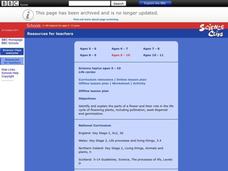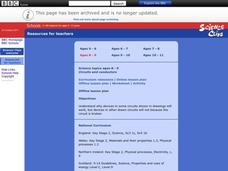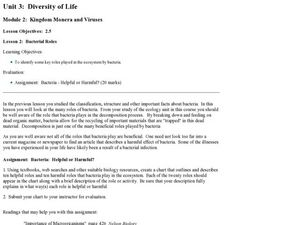Curated OER
Moving and Growing
Students work with a partner to brainstorm a list of as many human body parts as possible. Using that list, they circle any one of those that are bones. They are shown a model of the human skeleton and practice locating various bones. ...
Curated OER
Keeping Healthy
Students review what the heart does and why the muscles in the body need oxygen. As a class, they measure their pulse rate while they are resting and after they have jogged for three minutes. They are helped by their teacher to convert...
Curated OER
Grouping and Changing Materials
Students feel and observe different types of materials. Using the internet, they sort objects based on the materials they are made from and justify their reasons for putting it in a certain category. They identify objects that could...
Curated OER
Using electricity
Students explore how a switch can be used to break a circut. Students construct a simple series circuit and use it for a purpose. Students read the "The Lighthouse Keeper's Lunch,or one of the "Katie Morag" stories which clearly shows...
Curated OER
Helping plants grow well
Learners explore the effect of water, temperature and light on plant growth. Students are asked if they remember the LAW for plants. This is Light, Air(temperature) and Water, which all plants need for growth. Learners are divided...
Curated OER
Life cycles
Students identify and explain the parts of a flower and their role in the life cycle of flowering plants, including pollination, seed dispersal, and germination. Students recap the following information: that plants need light, warmth,...
Curated OER
Changing Sounds
Young scholars identify how the pitch of an instrument can be altered. They complete a worksheet by labeling several images in order of pitch and then fill a bottle with water to create a sound that matches a pitch on a drawn card.
Curated OER
Gases Around Us
Young scholars participate in a whole class discussion about solids, liquids, and gases. Students get involved in a teacher-directed experiment related to solids, liquids, and gases. Young scholars complete worksheet, writing the names...
Curated OER
Changing State
Students identify the changing states of water, water vapor and ice in the water cycle They investigate how each of these stages can be reversible. Students complete a worksheet describing the water cycle.
Curated OER
Circuits And Conductors
Students predict the common classroom items, such as paper clips, chalk, keys, or erasers, that will be good conductors in a circuit. They build circuits using a variety of circuit diagrams to test their predictions.
Curated OER
Genetic Decision Making Model
Learners examine case studies involving bioethics. They write a paragraph explaining the problem. Students construct a list of values that are involved in the conflict. They list probable solutions to the problem and consequences to...
Curated OER
Environment: Valley Walk-A-Thon
Pupils go on a nature hike and observe the different plants along their route. Various plants are circled with hula hoops and identified with flash cards. Older students write in their journals about their hiking experience while the...
Curated OER
Just Spray 'Em!?
Students read the label of an insecticide and identify pertinent information. They tell that the higher the LD50 the less toxic the chemical. Students begin to extrapolate the impact of pesticide use beyond the death of the insect.
Curated OER
CALORIE COUNTDOWN
Students will categorize foods according to their components and energy content.1. Design a large bulletin board with sections for carbohydrates, fats and proteins.
2. Ask students to bring labels and packages of different food products....
Curated OER
Hide & Seek Butterflies
Students examine a variety of butterflies and discuss how they believe they get their color variations. In groups, they brainstorm the advantages and disadvantages of their color schemes. To end the lesson, they watch butterflies in...
Curated OER
Match the Numbers: Level II
For this match the numbers worksheet, students match a set of numbers in a left column, with a set of shapes on the right, numbers 3, 4, 5, 7 and 10 are used.
Curated OER
Grade Five Vocabulary
In this vocabulary instructional activity, students match vocabulary words to definitions, 15 words total. Worksheet contains links to additional activities.
Curated OER
The Biological Carbon Cycle
Students learn about the biological carbon cycle. In this carbon cycle lesson, students access the web site and mouse over the diagrams to follow the carbon cycle. They read about what happens to humans and plants during this cycle.
Curated OER
Parent's Day
Students prepare for a parent's day. In this holiday lesson, students write invitations to their parents inviting them to attend a Thanksgiving meal. They plan out what they will be serving and setting up for a colonial flag...
Curated OER
Bacterial Roles
Students study bacteria and the role it plays in the ecosystem. In this bacteria instructional activity students research the roles bacteria has and submit a chart.
Curated OER
Sustainable Dining
Pupils identify consumer products and sustainable foods. They calculate the differences in prices and applying those prices to the cost of a meal. They also discuss the costs and benefits of buying sustainable products.
Curated OER
Understanding Food Labels
Students determine the number of calories, serving size, and vitamins and minerals in different food products and use this information to create a formula determining the number of calories per serving size and the daily percentages of...
Curated OER
Investigating Animals in Water
Young scholars observe small animal activity. They identify local water animals and describe the habitats where water animals can be found. Students collect samples to observe in the classroom.
Curated OER
Bat Habitat
Ninth graders engage in a lesson to find the role of bats in the complexity of certain ecosystems. They identify where bats live and the daily role played in the ecosystem. Students also construct a bat house to help control the...























